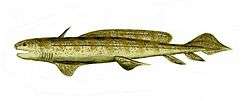Xenacanthida
| Xenacanthida Temporal range: Lower Carboniferous - Middle Triassic | |
|---|---|
 | |
| Orthacanthus senckenbergianus | |
| Scientific classification | |
| Kingdom: | Animalia |
| Phylum: | Chordata |
| Class: | Chondrichthyes |
| Subclass: | Elasmobranchii |
| Superorder: | Euselachii |
| Order: | Xenacanthida Glikman, 1964 |
| families and genera | |
|
See text. | |
Xenacanthida (or Xenacanthiforms) is an order of prehistoric sharks that appeared during the Lower Carboniferous period. The order includes the families Xenacanthidae, Diplodoselachidae, and Orthacanthidae. The most notable members of the group are the genera Xenacanthus and Orthacanthus. Some Xenacanthus may have grown to lengths of 4 m (13 ft). This group of sharks inhabited freshwater environments. Some forms had large serrated spines extending backwards from the neck. Xenacanthus had characteristic teeth. The base or root of each tooth had a pair of hook-like cusps. Most Xenacanthus died out at the end of the Permian in the Permian Mass Extinction, with only a few forms surviving into the Triassic period.
Taxonomy
- Family: Diplodoselachidae Dick, 1981
- Genus: Diplodoselache Dick, 1981
- Genus: Dicentrodus Traquair, 1888
- Genus: Hagenoselache Hampe & Heidkte, 1997
- Family: Orthacanthidae Heyler & Poplin 1989
- Genus: Orthacanthus Agassiz, 1843
- Family: Xenacanthidae Fritsch, 1889
- Genus: Plicatodus Hampe, 1995
- Genus: Triodus Jordan, 1849
- Genus: Xenacanthus Beyrich, 1848
- incertae sedis
- Genus: Anodontacanthus Davis, 1881
References
This article is issued from Wikipedia - version of the 4/27/2016. The text is available under the Creative Commons Attribution/Share Alike but additional terms may apply for the media files.